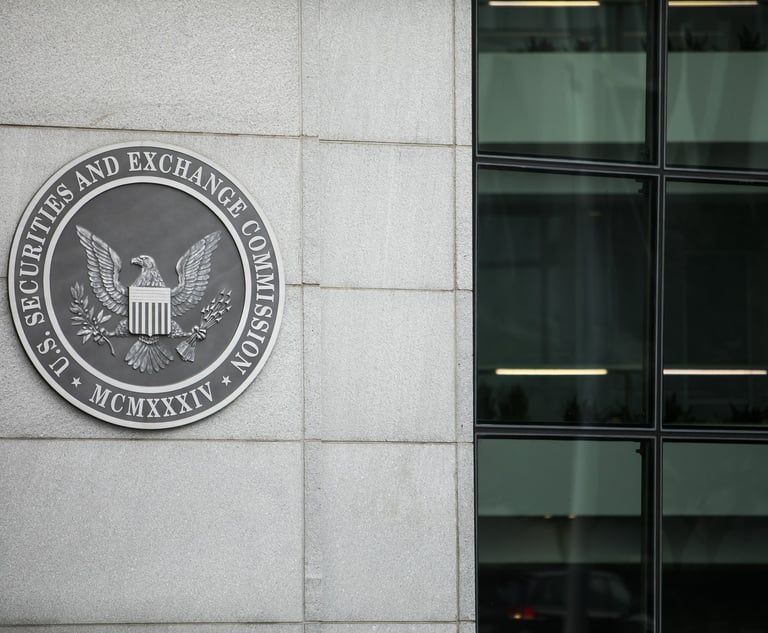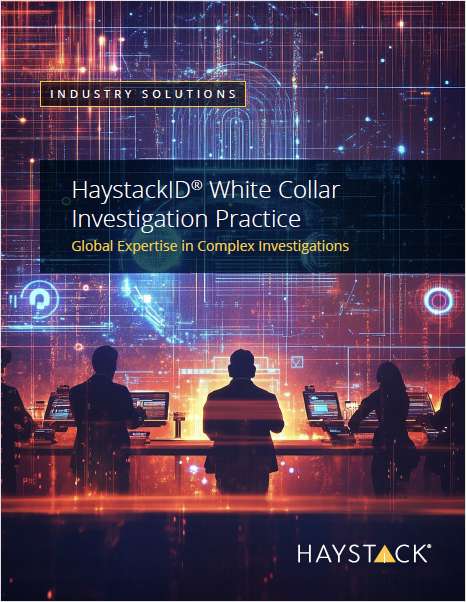 Photo: Elnur/Shutterstock.com
Photo: Elnur/Shutterstock.com'A Tidal Wave of Change': Plaintiffs Firms Are Tapping Data Analytics, but Some Are Still Reluctant
The plaintiffs bar has started getting into the Big Data game as well, although so far, the emphasis has been on case management.
January 27, 2020 at 05:08 PM
8 minute read
The original version of this story was published on The Legal Intelligencer
Editor's note: This is the first article in a series.
As in-house attorneys and defense lawyers bolster their use of data analytics tools and predictive coding to help them litigate cases, plaintiffs firms are also using emerging information technologies of their own—although when it comes to developing litigation strategies, most say that the old ways are still best.
According to a December article in ALM's Corporate Counsel, the insurance industry is leading the way when it comes to using predictive analytics and artificial intelligence to help develop litigation strategies, such as when to settle a case and what lawyers should be used before a specific judge. These "Moneyball" tactics, which can drill down into specific venues to determine the likelihood of a motion's success in front of a certain judge, have increasingly been adopted by other big companies' legal departments and defense firms.
The plaintiffs bar has started getting into the Big Data game as well, although so far, the emphasis has been on case management. When it comes to bringing actions in unfamiliar venues, most plaintiffs attorneys say they prefer sticking with human intelligence.
"If it's so easy to predict the outcome of a case, then why have 12 people sit in a box for a couple of weeks?" Philadelphia-based lawyer Jon Ostroff of Ostroff Injury Law said. "If you know the judge's philosophy and read about decisions they've made in other cases, you're going to find more of a way to resonate with them. … I would rather talk to members of the bar and lawyers I respected about their experiences with a specific judge."
Ostroff said he was not against using data analytics tools to help guide a case, but that many tools seemed to oversimplify the issues, and that tools like jury consultants and focus groups are far more beneficial for plaintiffs lawyers.
"To predict the approach of an insurance company in a negotiation may be useful, but then you have to be careful about overrelying on settlement tendencies and underrelying on the jury," he said. "You don't build a case to settle. You build a case to go to trial."
His sentiments were echoed throughout the plaintiffs bar.
"I'm not running a data analysis on what motion I'm going to file … I'm just talking to local counsel," Jim Beasley Jr. of The Beasley Firm said. "I don't think that it is as useful or critical, or even cost effective, for your typical plaintiffs guys. … At some point, you can have all the data in the world, but you can have a jury panel that you can't connect with."
However, one area where plaintiffs firms are advancing their technological capabilities is in case management. According to lawyers and tech industry officials, in the past three to five years, new platforms and services have begun to emerge specifically geared toward allowing law firms to better manage and understand their case loads. Companies, such as Litify, which spun off from the Florida-based firm Morgan & Morgan, and MERR Consulting Group, which was founded by two former paralegals from The Beasley Firm, have entered the market, finding that there is a big need from the plaintiffs bar.
"There's been a tidal wave of change coming into our space," said Shawn Lehocky, chief strategy officer for Pond Lehocky, a Philadelphia-based workers' compensation firm. "Traditionally law firms use case management systems, on the plaintiffs side, to manage files. Those systems were never meant to be a full enterprise system, where HR is tied into finances, and into marketing. Historically, every department had different software that didn't talk to each other."
With these new programs and platforms coming online, that is changing, according to Lehocky, whose firm uses the Litify platform and, through its business venture, LegalOps, develops niche applications for other firms that also use the program.
According to Lehocky, emerging technologies are allowing plaintiffs firms to more quickly identify cases that should be referred out to other firms, and keep tabs on those cases so there are shorter lag times if the referral is initially rejected. The technology can also help the firm identify other cases or needs that the plaintiff might have, which, along with providing better services, could provide another revenue stream for the firm. Even analyzing communications with clients can provide opportunities, Lehocky said.
"Our original website used the word 'attorney,'" Lehocky said. "We went back through our chats, and clients used the word 'lawyer,' not attorney. As simple as that may seem, as interchangeable as that may seem, I need to use the words that apply to them. The words that they're using."
The reason why the plaintiffs bar is more focused on case management may come down to the different business models each side uses.
"We have the incentive to be efficient in our time," Lehocky said. "The other side has a different incentive. They get paid by hours spent."
Ostroff noted that the emerging case management tools can also help firm leaders monitor the effectiveness of paralegals and attorneys, and its analysis of key intake metrics can help identify issues that may come up like motions that may need to be filed, or documents that may need to be tracked down.
However, some firms that focus on more document-heavy work have not been shy about using predictive tools in litigation—specifically, in discovery.
Attorneys with San Diego-based Robbins Geller Rudman & Dowd, which focuses on complex securities fraud and antitrust class actions, said e-discovery data analytics are key to culling through massive data dumps to help identify the key documents and then further prioritize them.
"It's going through all that information and figuring out what you want to target," Christine Milliron, the firm's director of e-discovery, said.
Along with creating visualizations of email chains to help attorneys determine who is talking with who, the tools can also help lawyers identify patterns and anomalies in the documents, such as increased communications in a given week on a topic, or when something is sent after normal hours. The tools can also help identify what documents might be missing.
Noting that the defense bar can also use these technologies to tweak discovery results, Robbins Geller partner Tor Gronborg said, "[The technology] can be used for good and it can be used for mischief."
According to Lea Bays, an of counsel lawyer with Robbins Geller focusing on e-discovery issues, knowing the ins and outs of the tools that opposing counsel uses can also help firms negotiate the terms of discovery to make sure key items don't get left out. She noted that sometimes defense lawyers push back on requests to reveal their search metrics, often blaming the plaintiffs for requesting too much information. But, she said, increased transparency should be beneficial to all parties.
"Everyone is interested in getting to the relevant documents faster and getting them out with less time wasted," Bays said. "Some of the arguments against [transparency] don't seem to make a lot of sense."
Thomas Kline of Philadelphia-based Kline & Specter, whose firm maintains large active dockets in mass tort programs, agreed that having tools to effectively manage and analyze documents is key. For instance, he said that, in preparing for the Risperdal trial that resulted in an $8 billion jury award, his team was able to quickly search the massive record for the words "halo" and "spillover effect"—terms allegedly used by the defendant's marketing department to describe off-label sales—so they could be referenced before the jury.
In mass tort cases, attorneys need access to individual medical records for each plaintiff, as well as access to the thousands of internal documents turned over by the defendant, which is partly why his firm, he said, recently decided to move to a new cloud-based case management system.
But still, according to Kline, there are some things data analytics cannot yet do, and identifying the truly significant passages and realizing how they might play in front of a jury is one of those things.
"You have to have a very good sense of what you are trying to prove and how you're going to prove it," he said. "There's no substitute for the human eye on the raw documents."
The next installment of the series will examine the trend of tech startups spinning out of plaintiffs law firms.
This content has been archived. It is available through our partners, LexisNexis® and Bloomberg Law.
To view this content, please continue to their sites.
Not a Lexis Subscriber?
Subscribe Now
Not a Bloomberg Law Subscriber?
Subscribe Now
NOT FOR REPRINT
© 2024 ALM Global, LLC, All Rights Reserved. Request academic re-use from www.copyright.com. All other uses, submit a request to [email protected]. For more information visit Asset & Logo Licensing.
You Might Like
View All
Will Trump Be a Boost to Quinn Emanuel's Fortunes in China?

Pa. Judicial Nominee Advances While Trump Demands GOP Unity Against Biden Picks
4 minute read
Trump's SEC Overhaul: What It Means for Big Law Capital Markets, Crypto Work
Trending Stories
- 1Gibson Dunn Sued By Crypto Client After Lateral Hire Causes Conflict of Interest
- 2Trump's Solicitor General Expected to 'Flip' Prelogar's Positions at Supreme Court
- 3Pharmacy Lawyers See Promise in NY Regulator's Curbs on PBM Industry
- 4Outgoing USPTO Director Kathi Vidal: ‘We All Want the Country to Be in a Better Place’
- 5Supreme Court Will Review Constitutionality Of FCC's Universal Service Fund
Who Got The Work
Michael G. Bongiorno, Andrew Scott Dulberg and Elizabeth E. Driscoll from Wilmer Cutler Pickering Hale and Dorr have stepped in to represent Symbotic Inc., an A.I.-enabled technology platform that focuses on increasing supply chain efficiency, and other defendants in a pending shareholder derivative lawsuit. The case, filed Oct. 2 in Massachusetts District Court by the Brown Law Firm on behalf of Stephen Austen, accuses certain officers and directors of misleading investors in regard to Symbotic's potential for margin growth by failing to disclose that the company was not equipped to timely deploy its systems or manage expenses through project delays. The case, assigned to U.S. District Judge Nathaniel M. Gorton, is 1:24-cv-12522, Austen v. Cohen et al.
Who Got The Work
Edmund Polubinski and Marie Killmond of Davis Polk & Wardwell have entered appearances for data platform software development company MongoDB and other defendants in a pending shareholder derivative lawsuit. The action, filed Oct. 7 in New York Southern District Court by the Brown Law Firm, accuses the company's directors and/or officers of falsely expressing confidence in the company’s restructuring of its sales incentive plan and downplaying the severity of decreases in its upfront commitments. The case is 1:24-cv-07594, Roy v. Ittycheria et al.
Who Got The Work
Amy O. Bruchs and Kurt F. Ellison of Michael Best & Friedrich have entered appearances for Epic Systems Corp. in a pending employment discrimination lawsuit. The suit was filed Sept. 7 in Wisconsin Western District Court by Levine Eisberner LLC and Siri & Glimstad on behalf of a project manager who claims that he was wrongfully terminated after applying for a religious exemption to the defendant's COVID-19 vaccine mandate. The case, assigned to U.S. Magistrate Judge Anita Marie Boor, is 3:24-cv-00630, Secker, Nathan v. Epic Systems Corporation.
Who Got The Work
David X. Sullivan, Thomas J. Finn and Gregory A. Hall from McCarter & English have entered appearances for Sunrun Installation Services in a pending civil rights lawsuit. The complaint was filed Sept. 4 in Connecticut District Court by attorney Robert M. Berke on behalf of former employee George Edward Steins, who was arrested and charged with employing an unregistered home improvement salesperson. The complaint alleges that had Sunrun informed the Connecticut Department of Consumer Protection that the plaintiff's employment had ended in 2017 and that he no longer held Sunrun's home improvement contractor license, he would not have been hit with charges, which were dismissed in May 2024. The case, assigned to U.S. District Judge Jeffrey A. Meyer, is 3:24-cv-01423, Steins v. Sunrun, Inc. et al.
Who Got The Work
Greenberg Traurig shareholder Joshua L. Raskin has entered an appearance for boohoo.com UK Ltd. in a pending patent infringement lawsuit. The suit, filed Sept. 3 in Texas Eastern District Court by Rozier Hardt McDonough on behalf of Alto Dynamics, asserts five patents related to an online shopping platform. The case, assigned to U.S. District Judge Rodney Gilstrap, is 2:24-cv-00719, Alto Dynamics, LLC v. boohoo.com UK Limited.
Featured Firms
Law Offices of Gary Martin Hays & Associates, P.C.
(470) 294-1674
Law Offices of Mark E. Salomone
(857) 444-6468
Smith & Hassler
(713) 739-1250









